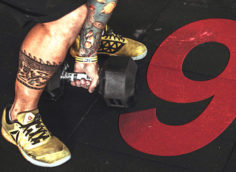The hips are the drivers of all powerful movement, and they should be able to move in three dimensions. But modern living makes your hips immobile and your favorite gym exercises may even be limiting your hip strength. Luckily, several mobility drills will unlock the hips and restore good movement.
Hip movement in three planes (3D or tri-plane movement) is critical for any powerful upper or lower-body movement. Hip extension and flexion (both sagittal plane motions) are important for squats, deadlifts, lunges and sprints.
Everything from throwing a punch to getting out of your car requires you to not only flex and extend the hips, but adduct, abduct, and rotate them both internally and externally. Many of these motions occur all at once, as you see here:

Poor hip mobility robs you of your ability to generate and absorb force in both the upper and lower body. Poor hip mobility may generate low back pain, knee pain, even shoulder pain. So everyone needs tri-plane hip mobility.
Squats, deadlifts, kettlebell swings, leg presses, and jumps do a decent job of dealing with hip flexion/extension, but none of these exercises do much to facilitate frontal or transverse-plane movement. Most exercises are done bilaterally and loaded symmetrically.
That doesn't make them bad, but your ability to move well may be compromised if you don't add some variety to your routine. Time to mobilize the hips in some new ways.
Kneeling Hip Flexor Stretch
Kneeling Hamstring Stretch, Internal/External Rotation
Kneeling Groin Stretch
Modified Pigeon Stretch
Standing Adduction
When To Do These Drills
In learning any skill, frequent practice will help you advance quickly. Pick just one drill and spend a few minutes doing it. Later in the day, do another drill. Repeat throughout the day. That way you can get your work done without taking up a big block of time.
You can also do any of these drills before your workout or between sets of other exercises. Or toss a few in on rest days during a deload week. You'll find that you're far more limited in one or two of these movements than you are in others. Spend a little more time improving those restricted areas.
This stuff may be about as exciting as brushing your teeth or wiping your ass, but I assume you do both. So if it's important, then get it done!
The best way to take advantage of your new hip mobility is to use it and strengthen it. One of the best ways to strengthen the hips is with lunges done in several directions – a lunge matrix.
Variables to play with include:
- Load: Bodyweight, barbells, dumbbells, kettlebells, or weight vest
- Range: Short, medium or long-range
- Environment: Lunge up to a step or lunge down from a step
- Speed: Slow to fast
- Stability: Try holding a dumbbell or kettlebell in one hand create an offset load
- Duration: Low to high reps, or for time
Start with just bodyweight. Start slow and simple. Familiarize yourself with the easiest versions of these lunges. You may find some of them to be awkward and challenging to your sense of balance.
Example: You try a sumo stance deadlift (test) but you're extremely tight in the groin and it's awkward. You do the 3D groin mobility matrix and return to the sumo deadlift (re-test). Are you more comfortable? Do you move better? If so, then you know that drill helped. The test and re-test approach can be applied to any number of exercises and any number of mobility drills.
Note: If you're injured and in pain, then visit some sort of medical professional.
Don't turn the mobility work into a competition with yourself. Don't stretch to the point of extreme discomfort. You'll only tighten up more. And don't rush. Stay in control, be precise, and be mindful as you move.
Some people may experience significant improvements in mobility with just one drill and a few minutes of work. Other times progress is slower. Much like adding pounds to a lift or putting on muscle mass, it may take weeks to see noticeable improvement. Stick with it and give these drills a chance to work.





